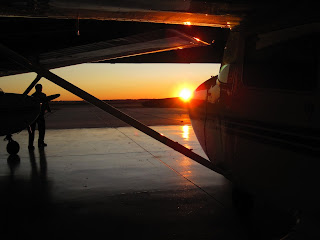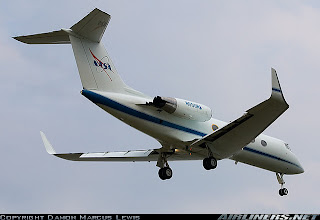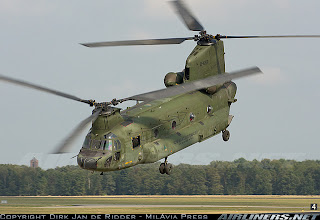What a day for flying! I started it off waking up to my alarm at 6:45 and thinking it was way to early. Then I remembered today was the day for my first cross country! Hitting it for snooze, I slept 5 more minutes before getting up and doing my usual routine of showering and usually finding nourishment of some sort. Being a college kid
and a pilot, sometimes I miss breakfast at the cafeteria. So I devised a way to have cold cereal in the morning without a fridge. Powdered milk, cold water, and boxed cereal. It works out fine.
I drove to the airport at around 7:15, right into the beautiful sunrise. Dan was at the airport already, and was pulling out planes. While I preflighted and fueled the plane, I snapped a couple of pictures.
Jason, the instructor taking me up on my cross country arrived around 8:05, after all the preflight for the plane was done, we went over my cross country sheet that I had to fill out. This basically has the heading (corrected for magnetic deviation, wind, and compass variance) you will fly, the fuel burn for each leg, time for each leg, estimated true airspeed as well as ground speed, diagrams of the airports you will be fling to and their frequencies, the weather briefing, among other things. It is quite a load to take on as a student pilot and I must say I haven't quite mastered the art of doing it myself yet. As we finished we got into the airplane and took off, full of fuel and ready to go!
We leveled off at 4,500, looking for 2400 rpm and 110 ktas (knots true air speed). Our first stop was Hays, a non towered airport about 70 nm (nautical miles) North West of Newton. We the would fly to Hutchinson, a towered airport (another 70 or so miles back south east. Hays was not a problem. Once the airport was in sight I made my radio calls, entered the pattern and made my touch and go landing. Once on the ground I cleaned up and then pushed full throttle again and we departed to the SE.
Let me say that the legs between the airports can get quite long, so I busied myself with scanning for traffic, examining the chart and referencing it with the ground. Cockpit conversation was good, but after a while you settle into the rhythm of flying and talking is not needed to pass the time.
About 30 miles out, I tuned to the Hutchinson tower frequency and started listening to traffic within that radius. This was my first time to a towered airport and it operates slightly different than a non towered airport. About 10 miles out I made my radio call. "Hutchinson tower, Cessna niner five niner Hotel Charlie is ten miles to the north west for touch and go, with information India." The last part is basically what weather briefing you received from the ATIS. The tower then contacted me telling me to fly a left downwind for 36 (the same traffic pattern applies to light aircraft at towered airports as it does at non towered airports). Right about when I was to turn base the tower cleared me "for the option" which basically means I can full stop or touch and go. I chose to touch and go because we were running a little short on time. As soon as we took off and were on the upwind leg, the tower cleared us to depart to Newton and approved us to change our frequency. The only other traffic in the area at the time was a hellicopter doing some low maneuvering over the city, which we had in sight. The flight to Newton was uneventful and while on final, I noticed Paul (a community student, a surgeon, who is refreshing his commercial pilots license again after many years) taxiing to 35 in his Pitts Special. Apparently he was going to fly to a steakhouse for lunch. After landing and taxiing to the hangar I noticed a beautiful Cessna 160 parked at our hangar. Another student (who had his own plane) was getting his tail wheel endorsement.
Later on that day I flew my final solo flight for stage 3. And what a flight it was! I departed 17, with quite a bit of crosswind. I departed to the west practice area over Hesston and descended to 2,500 to practice my rectangular course maneuvers. I started on the downwind leg and was just about to turn base when something caught my peripheral vision. I snapped my head around and saw two tail draggers flying in formation, intersecting my path not more than 100 feet below me. I slammed on the throttle and hauled back on the elevator. After the adrenaline subsided I evaluated the situation. They looked like restored planes, either without radios or were on another frequency. They came from my left quarter, so were hidden until I made my turn. Recently I have been focusing on holding my altitude when maneuvering. I tend to fluctuate around 100 feet. How glad I was that I was at 2,500 and not below. The incident could have turned to an accident, as the planes were on a direct intersect course below me. If there are any pilots out reading this, PLEASE! USE CTAF AND TALK ON THE RADIO!! You can protect yourself as well as others.
Thus ends my eventful day of flying. Once again I sit back and ask myself, "A pilot? Is this really for me?" Then I smile. "You bet!"

Beautiful morning

clear skies

The Cessna 160 sitting at the HCA ramp


